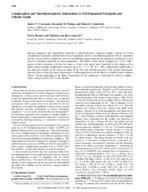| dc.contributor.author | Chernook, A. V. | en |
| dc.contributor.author | Shulga, A. M. | en |
| dc.contributor.author | Zenkevich, E. I. | en |
| dc.contributor.author | Rempel, U. | en |
| dc.contributor.author | Borczyskowski, C. von | en |
| dc.date.accessioned | 2017-05-18T18:43:26Z | |
| dc.date.available | 2017-05-18T18:43:26Z | |
| dc.date.issued | 1996 | |
| dc.identifier.citation | Complexation and interchromophoric interactions in self-organized porphyrin and chlorin triads / A. V. Chernook [et al.] // Journal of Physical Chemistry. – 1996. – Vol. 100, № 5. – P. 1918-1926. | en |
| dc.identifier.uri | https://rep.bntu.by/handle/data/30019 | |
| dc.description.abstract | Spectral properties and equilibrium constants of multimolecular complexes (triads) formed by 2-fold coordination of dipyridyl-substituted free bases of porphyrin, chlorin, or tetrahydroporphyrin with Zn-porphyrin and Zn-chlorin dimers bridged by either of two different spacers between the monomeric entities have been studied in methylcyclohexane at room temperature. The ability of the dimers bridged by a -CH2-CH2- spacer to form complexes with the free bases is found to be much lower than that for the dimers with a phenyl spacer having complexation constants up to Kc = 5 × 10⁷ M⁻¹. The complexation equilibrium is also affected strongly by the chemical nature of the free base and the position of the pyridyl substituents.
Spectral effects occurring upon complexation in absorption spectra of the dimers are mainly due to ligation effects. Strong quenching of the dimer fluorescence in the complexes is attributed to effective singlet-singlet energy transfer (ET) to the ligands. | en |
| dc.language.iso | en_US | en |
| dc.title | Complexation and interchromophoric interactions in self-organized porphyrin and chlorin triads | en |
| dc.type | Article | ru |
| dc.identifier.doi | 10.1021/jp951108h | |

